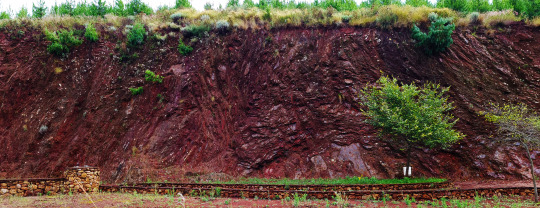#IRONSTONE
Explore tagged Tumblr posts
Text

Ladies’ Home Journal Book of Interior Decoration, 1959
#vintage#interior design#home#vintage interior#architecture#home decor#style#1950s#50s#dining room#plaid#blue#fireplace#dinnerware#Hitchcock chair#side chair#traditional#ironstone
142 notes
·
View notes
Text


edward ironstone ♱
#ironstone#vampy#aesthetic#fashion#gothic#goth#goth aesthetic#gothcore#alternative goth#goth fashion#romantic goth#dark aesthetic#gothic fashion#gothic aesthetic#vampcore#vampy vibes#vampire aesthetic#vampiric#vamp goth#vamp aesthetic#vampirecore#vampire goth#web finds#goth subculture#alternative#vocalist#prog metal#progressive metal#men
169 notes
·
View notes
Text
Banded Iron Formation


Here's a photo of a beautiful 3.4 Ga banded iron formation from the Barberton Geo Trail, South Africa. It's heavily weathered, but there was still some green underneath the oxides. Exposure is ~3m high. #Geology
67 notes
·
View notes
Text





1850s Davenport Friburg Ironstone Stoneware Transferware Platter 💙
14 notes
·
View notes
Text

Ironstone live.
2 notes
·
View notes
Text
Nobody asked but my HC for Seb's facial structure is basically this man.
instagram
13 notes
·
View notes
Text
"what's your favorite band rn?"
Erm actually I love all of my cults equally thank you
(Don't make me choose)
Teehee

#help me its 5 am#kiss band#gvf#slaughter band#deep purple#maneskin#motley crue#rob zombie#korn band#palaye royale#cinderella band#bon jovi#Hozier#arctic monkeys#gorillaz#nine inch nails#guns n roses#megadeth#metallica#pink floyd#black sabbath#ozzy osbourne#deftones#fish in a birdcage#ironstone#trixter#faster pussycat#led zeppelin#the ramones#80's rock
6 notes
·
View notes
Text

#vintage#pretty#blue#blue and white#collectibles#replacemt piece#cake stand#pottery#ironstone#loch#scotland
2 notes
·
View notes
Audio
🆕🎶 「 TETSU 」 new single by IRONSTONE, KyonCeeAPartment is now available worldwide! 🌐 Listen now on our weekly updated playlist and discover new sounds from Japan 🎧 https://spoti.fi/42HdAgd
0 notes
Text
Shut Your Mouth × Forbear pre.”Alkaline Maniacs″
2023年9月最終日
Shut Your MouthとForbearで共同企画を催します。
夏の終わり、秋の始まりに是非遊びに来てください。
—————————————
2023/9/30(Sat) Shimokitazawa SPREAD
Shut Your Mouth × Forbear pre .”Alkaline Maniacs″
□ Shut Your Mouth
□ Forbear
□ Otus
□ ZAP THE ALL TOWN
□ IRONSTONE feat. 13DR,KyonCeeAPartment,MUTA,DF¥ from東金B¥PASS
open 17:00 start 17:30
adv.2,500( +1D) door.3,000( +1D)
予約 (reserve) 👉https://forms.gle/YfcCxe3VDEnyhRgb9

0 notes
Text
A cute little billion year old coated grain that looks like a sprout. The grain is made of layers of Fe-clay that grew on the sea bed. Normally these grains are smooth but mine have unusual textures. I'm trying to figure out how these things formed. This little grain is about 1 mm across and is hosted in a shadow water sandstone.

#geology#palaeontology#geologyjohnson#fossils#precambrian#fossil#fossilfriday#paleontology#ooid#green#acritarch#iron formation#ironstone#sandstone
4 notes
·
View notes
Text

Old Ironstone Jug and Roses - Ernest Procter , 1930.
British , 1886-1935
Oil on canvas , 46 x 35.5 cm.
97 notes
·
View notes
Text

10 notes
·
View notes


